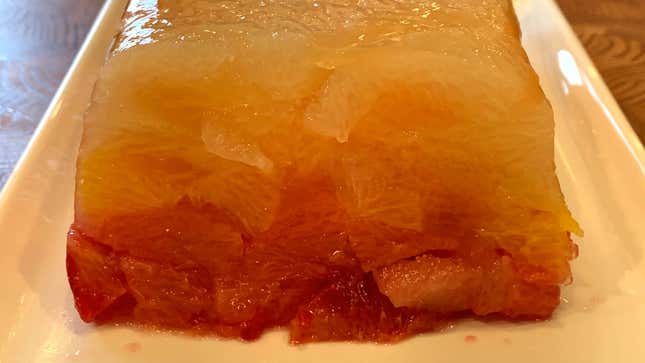
It’s the dead of winter, and most of the fun holidays are behind us—but there’s still months of cold and slush to get through. So we’d like to welcome you to Tropical Staycation, a week of island-inspired recipes and other stories that will transport you to much warmer, sunnier places. Just don’t look out the window while reading.
We’re now smack-dab in the middle of citrus season. At any local grocer, you can find up to three different colors of grapefruit, oranges of every type, sweet-tart Meyer lemons, and tangerines that range from the size of quail eggs to giant Sumos. Fancier stores might carry pomelos, blood oranges, kumquats, even Buddha’s hand. And new varietals hit the stores all the time, from pink cara cara oranges to small green cocktail grapefruit to super-sweet MeloGolds.
While I love to keep these on hand for eating, one of my favorite things to do with them is make a terrine for dessert. Winter dinner parties are notorious for being a celebration of rich, long-simmered or stewed or braised food: we want stick-to-our-ribs soulful cooking when the light goes away at four in the afternoon and the chill gets into our bones. But at the end of an indulgent meal, a light and bright dessert will send guests home with a bit more spring in their step. This terrine is almost magical because it could not be simpler to make, has great showstopper wow factor on the plate, and can be served as everything from a brunch dish to a super fancy dinner party. It can be garnished in all sorts of ways, and you can experiment with the combinations you like best.
For a fancy party, I might get two or three colors of grapefruit, blood orange, navel orange, and Meyer lemon to create an ombre effect ranging from red to yellow for an edible sunset. Or mix them all in willy-nilly for a stained-glass effect. I might go with all one flavor, just grapefruit or just orange, or I might toss in every citrus fruit I can find.
Garnishes can be as simple as a dollop of whipped cream or vanilla yogurt, or as complex as a black pepper caramel sauce with toasted pistachios and rose petals. You can use gelatin (as this recipe dictates), which holds the terrine together, or use just juice, maybe with a splash of wine or liqueur. Once you start making it, you’ll find all sorts of ways to make it your own.

Citrus Terrine
Serves 8-10
The key to this recipe is to supreme your fruit. This means cutting the ends off the fruit to expose the segments, then cutting away all the peel around the outside and carefully using a paring knife to cut between the skin that separates the segments. You should be left with only the flesh of the fruit. Supreming will also allow you to remove any seeds. As you remove the segments, squeeze the membranes over a bowl to capture the juice.
- 8 cups supremed citrus fruit (I like a combo of grapefruit, orange, tangerine, and Meyer lemon, but use what you love)
- 1 3/4 cups reserved juice from cutting up the fruit (You will also have juice in the bottom of the bowl with the segments that you can pour off.)
- 1 Tbsp. sugar (or vanilla sugar)
- 2 (1/4-oz.) packages powdered unflavored gelatin
Line a 9x5 loaf pan with plastic wrap, leaving a five-inch overhang. Put 3/4 cup of your juice into a bowl, sprinkle the gelatin over it, and let sit to bloom for 15-20 minutes. Layer your fruit into the loaf pan in any way you like, but don’t pack it too tightly: you want some spaces for the gelatin to seep into. Also be sure to leave at least a quarter-inch of headspace so that the gelatin will seal all the fruit in and allow you to make neat slices.
In a small saucepan, heat the remaining cup of juice with the sugar. Once it starts simmering, add the bloomed gelatin and stir until fully dissolved. Carefully pour the gelatin over the fruit in the pan, allowing it to seep into all of the crevices. Place the plastic wrap over the top of the fruit, and chill for at least 4-6 hours, though overnight is preferable.
To serve, unmold using the plastic wrap and slice into inch-thick slabs.